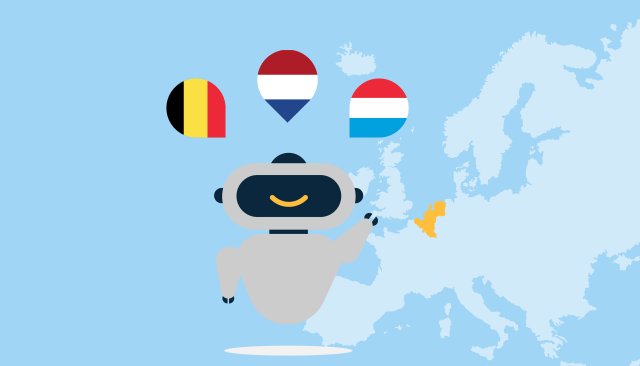As a nation of vibrant cultures and languages, India presents both, unique opportunities and challenges for businesses looking to engage with a diverse audience. With over 100 languages spoken across the country, communication can become a complex puzzle. This is where the concept of multilingual WhatsApp bots comes in, offering an effective solution to bridge linguistic gaps and expand your reach.
India's linguistic landscape is unique in the world. There are 22 official languages, 121 native languages people speak, and when you count in regional dialects as well, there are 19,569 linguistic variations Indians use.
For businesses, that's a formidable opportunity to use the customers' preferred language as a way to personalize interactions, and connect even better with them. At the same time, it's a challenge to offer multilingual communication, as it requires regional knowledge and resources.
That's where multilingual chatbots come in. By deploying multilingual chatbots on India's favorite communication platform, WhatsApp, businesses will be able to meet their customers on a more personal level, connect better, enhance the customer experience, and grow their business.
In this comprehensive guide, we will explore the benefits of using multilingual WhatsApp bots, delve into use cases, and guide you on how to set up these bots to connect with your audience effectively in India.
Unlocking the benefits of multilingual WhatsApp bots
If you truly want to reach India's diverse audience, WhatsApp is the place to be! No matter the region, the language, or the remoteness of an area: pretty much everyone in India that uses a smartphone also uses WhatsApp.
As WhatsApp is the starting point for almost every conversation between customers and businesses, integrating a multilingual WhatsApp bot can bring great benefits to your company.
Enhanced customer engagement
By conversing with your customers in their preferred language, you break down barriers and create a more engaging and relatable interaction. This is essential for building trust and loyalty.
Wider audience reach
India's linguistic diversity is a testament to its multicultural population. A multilingual WhatsApp bot enables your business to reach a more extensive and varied customer base, ensuring that no one is left out.
Improved customer satisfaction
When customers can communicate with your brand in their native language, they are more likely to be satisfied with your services. It reduces misunderstandings and enhances the overall customer experience.
Efficient support and query resolution
A multilingual WhatsApp bot can quickly address customer queries, providing immediate assistance and solving problems in the language your customers understand best.
Cost savings
While setting up a multilingual bot may require an initial investment, it can lead to substantial cost savings in the long run. You can handle customer interactions more efficiently without the need for hiring multilingual staff.
Use cases: When to employ multilingual WhatsApp bots
Multilingual WhatsApp bots can be applied across various sectors and business functions. Here are some use cases that illustrate their versatility:
Customer support
Imagine a customer in Tamil Nadu seeking assistance for a product issue. With a multilingual WhatsApp bot, you can offer support in Tamil, addressing their concerns promptly and effectively.
E-commerce and sales
In a diverse market like India, language plays a crucial role in driving sales. Multilingual bots can showcase product details, offers, and purchasing options in the customer's preferred language, leading to higher conversion rates.
Booking and reservations
Companies in the travel and hospitality industry can greatly benefit from multilingual bots. Customers can book flights, hotels, or tickets in their language of choice, simplifying the process and enhancing their experience.
Healthcare and telemedicine
In the healthcare sector, multilingual WhatsApp bots can offer information about symptoms, book appointments, and provide medical advice in various languages, ensuring that health-related queries are addressed accurately.

Information dissemination
Government agencies or educational institutions can use multilingual bots to share crucial information, updates, and announcements with the public, ensuring that the content is accessible to all.
Setting up a multilingual WhatsApp bot
While the benefits of multilingual WhatsApp bots are clear, setting one up can be challenging for companies due to the complexities involved. Here's a step-by-step guide to help you get started:
1. Identify target languages
Determine the languages most relevant to your audience. In the Indian context, Hindi, English, Bengali, Telugu, Marathi, Tamil, Urdu, and others may be essential languages to support.
2. Choose a technology stack
Select the right technology stack or platform to develop your multilingual bot. This choice depends on your company's technical capabilities, budget, and specific requirements.
3. Data collection and training
Collect and curate language-specific data sets and train your bot's natural language processing (NLP) model. This ensures that the bot understands and responds accurately in each language.
4. Integration with WhatsApp API
To use your multilingual bot on WhatsApp, you must integrate it with the WhatsApp Business API, as the WhatsApp Business app doesn't support chatbot integration. This step often requires IT knowledge and experience if you want to go about it yourself.
Alternatively, you can work with WhatsApp Business Solution Providers that offer out-of-the-box WhatsApp solutions for companies. Sinch Engage, for instance, is a Business Solution Provider where you can build a WhatsApp bot in a few minutes yourself, work with templates, and even upgrade to more sophisticated WhatsApp AI chatbot solutions.
5. Testing and fine-tuning
Thoroughly test your bot in each supported language, identify any issues, and fine-tune its responses. User feedback is valuable during this phase.
6. Maintenance and updates
Multilingual bots require ongoing maintenance, including updating language models, adding new languages, and ensuring that the bot stays current and relevant. If you work with a Business Solution Provider, they can help you take care of maintenance as well.
7. Compliance with regulations
Ensure that your multilingual bot complies with WhatsApp's regulations and policies for business use.
Simplifying the process with cost-effective solutions
Setting up and maintaining a multilingual WhatsApp bot can indeed be complex, requiring IT expertise, ongoing maintenance, and, at times, substantial costs. However, there are cost-effective and user-friendly solutions available for businesses seeking to navigate India's linguistic diversity seamlessly.
One such solution is Sinch Engage, a trusted partner for businesses looking to implement multilingual WhatsApp bots. Sinch Engage offers a suite of services that simplify the process, from bot development and training to integration with the WhatsApp Business API. With Sinch Engage, your business can efficiently deploy multilingual WhatsApp bots, ensuring that language is no longer a barrier to effective communication with your customers in India.
Breaking down language barriers in India
India's linguistic diversity is a testament to its rich cultural heritage, but it can present challenges for businesses looking to connect with a wide-ranging audience. Multilingual WhatsApp bots offer a solution that bridges these linguistic gaps, allowing companies to engage with their customers in a more personal and efficient manner.
While setting up a multilingual WhatsApp bot can be challenging due to the need for IT knowledge, maintenance, and costs, companies have accessible and cost-effective solutions like Sinch Engage at their disposal. By embracing these solutions, businesses can unlock the benefits of enhanced customer engagement, wider audience reach, improved customer satisfaction, efficient support, and cost savings.
In the end, the power of multilingual WhatsApp bots lies in their ability to turn India's linguistic diversity into a valuable asset, connecting businesses and their customers in meaningful ways.






